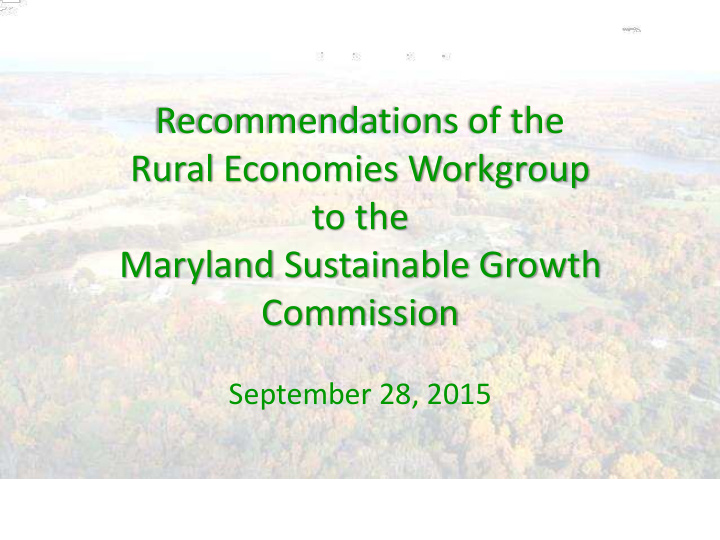



Recommendations of the Rural Economies Workgroup to the Maryland Sustainable Growth Commission September 28, 2015
Why Preserve Land?
Why Preserve Land?
Why Preserve Land?
Why Preserve Land?
How do land preservation programs work?
What programs are available in Maryland? State Programs Maryland Environmental Trust Maryland Agricultural Land Preservation Foundation Rural Legacy Program County Programs Transferable Development Rights Easement Purchase * STATE & COUNTY PROGRAMS ARE VOLUNTARY and NONE REQUIRE PUBLIC ACCESS *
MET Program Highlights Preserved over 1,070 properties, totaling over 132,000 acres in Maryland Owner donates perpetual conservation easement Benefits – tax deduction & estate planning No deadline to apply; however, if owner wants to donate in a particular year, must submit by September. http://www.dnr.state.md.us/met/
The Maryland Agricultural Land Preservation Foundation
Rural Legacy State began program in 1997 Encourages local governments and private land trusts to identify Rural Legacy Areas and to competitively apply for funds Easement and fee simple purchase Over 83,000 acres protected
All Maryland counties contain at least one Rural Legacy Area
Rural Legacy — Con’t Easement does not grant public access. Owners who offer public access get higher ranking & easement value if it is offered Lump sum payment for easement Property must be located within a designated Rural Legacy Area Owner needs to indicate interest to be on eligibility list
Land Preserved, Developed, or Neither in Maryland, Outside Baltimore City 60% 48.21% 50% 40% 30% 26.12% 25.67% 20% 10% 0% Land Preserved in Maryland Land Developed in Maryland Neither Developed nor (Easement and Public Preserved Ownership) Source: MDP, September 2015
Recommendation 1 Recognize that land preservation is economic development and makes fiscal sense The Governor & General Assembly can support this with a perspective that $$$ for land preservation is good policy AND essential to rural resource-based economic development Preservation costs less than government servicing rural land after it is developed and, therefore, saves taxpayers money
Recommendation 2 Safeguard and Fully Fund Land Preservation Stop diverting state revenues through the legislative budgeting process from the real property transfer tax and the agricultural land transfer tax, which are dedicated to Program Open Space, Agriculture Land Preservation Fund, Rural Legacy Program, and Heritage Conservation Fund; Utilize the initial percentages of revenue distribution established by the legislators for the intended purposes of land preservation, recreation and heritage areas; and If state transfer tax funds are still diverted in the future, a constitutional amendment to have a “lockbox” for land preservation funds should be considered.
Recommendation 3 Consider raising the annual state income tax deduction cap for donated / discounted easement sales Consider making the tax credit transferable In the meantime, amend Article - Tax – General §10 – 723 to make the tax credit easier to use
Recommendation 3 — Con’t Virginia acquires most of its easements through a transferable tax credit program It allows an income tax credit for 40% of the value of donated land / easements Taxpayers may use up to $100,000 per year for year of sale and 10 subsequent tax years Unused credits may be sold, allowing individuals with little or no Virginia income tax burden to take advantage of this benefit Virginia’s program doesn’t prioritize the location or resource value of its easements, but that can be changed in MD
Recommendation 4 Be briefed by the TDR Committee when it finishes it work early in 2016 and consider endorsing its recommendations
Recommend
More recommend